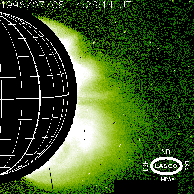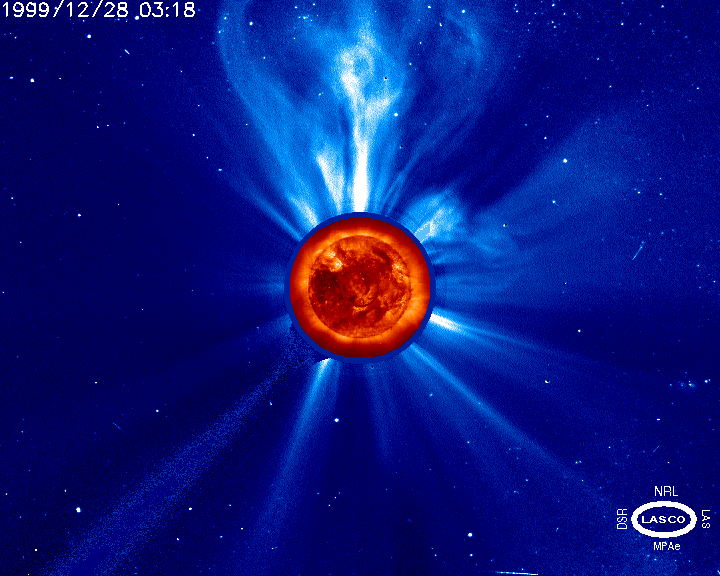Movie Gallery
|page 1 | page 2 | page 3 | page 4 | page 5 | SOHO-Gallery |Coronal Mass Ejections
|9603c1ro | 9605c1ro | 9606c1sm | 960708c1 | 9608c1c2 | 961018c1 | c3_2year | fastSW | Xmas99 | May2kv3 |
9603c1ro  The inner corona in March 1996, a time period of extremely low solar activity,observed by LASCO-C1 at a wave length of 530.3 nm. The continuum intensity at 530.9 nm was subtracted from each image.The residual intensity made visible this way is emitted from coronal Fe-XIV ions at a temperature of 1.5 million degrees. There are 10 images/day with data gaps interpolated accordingly (seconds marked as ":01"). The images are not calibrated by suitable flatfield images.A scientific discussion of this movie can be found in the publication by Schwenn et al. in Solar Physics special issue II (1997). |
9605c1ro  The inner corona during two solar rotations in summer 1996, a time period of low solar activity, observed by LASCO-C1 at a wave length of 530.3nm. The continuum intensity at 530.9 nm was subtracted from each image. The residual intensity made visible this way is emitted from coronal Fe-XIV ions at a temperature of 1.5 million degrees. There are 10 images/day with data gaps interpolated accordingly (seconds marked as ":01"). In the center of the images, the strength of the photospheric magnetic field is displayed in a color code (light green: positive field directed away from the Sun, dark green: negative field, directed towards the Sun, the solid line represents the magnetic neutral line). The photospheric magnetic field data were kindly supplied from the Wilcox Solar Observatory, Stanford, USA. |
9606c1sm  A sequence of CMEs above the western limb of the Sun in June 1996, observed by LASCO-C1 at a wave length of 530.3 nm. The continuum intensity at 530.9nm was subtracted from each image. The residual intensity made visible this way is emitted from coronal Fe-XIV ions at a temperature of 1.5 million degrees.The time between two consecutive image varies al little and is rougly 45min.In the center of the images, the strength of the photospheric magnetic field is displayed in a color code (light green: positive field directed away from the Sun, dark green: negative field, directed towards the Sun, the solid line represents the magnetic neutral line). The photospheric magnetic field data were kindly supplied from the Wilcox Solar Observatory, Stanford, USA. |
960708c1  A slow mass ejection from the corona observed by LASCO-C1 at a wave length of 530.3 nm. The continuum intensity at 530.9 nm was subtracted from each image. The residual intensity made visible this way is emitted from coronal Fe-XIV ions at a temperature of 1.5 million degrees. The images are not calibrated by flat field images, pixel defects by cosmic ray hits have no yet been removed. |
15 frames, 388x388, 2.15MB (MVI), 0.66MB (MPEG), source: MPS
961018c1  Two CMEs observed by LASCO-C1 at a wave length of 530.3 nm. The continuum intensity at 530.9 nm was subtracted from each image.The residual intensity made visible this way is emitted from coronal Fe-XIV ions at a temperature of 1.5 million degrees. The images are not calibrated by flat field images,pixel defects by cosmic ray hits have not yet been removed. |
9608c1c2 The solar corona during the 'Whole Sun Month' (10. Aug. - 8. Sep. 1996),observed by LASCO-C1 at a wave length of 530.3nm and by LASCO-C2 in white light.In the center of the images, the strength of the photospheric magnetic field is displayed in a color code (red: positive field directed away from the Sun, blue: negative field, directed towards the Sun). The photospheric magnetic field data were kindly supplied from the Wilcox Solar Observatory, Stanford, USA. |
c3_2year
|
2848 frames, 512x512, 96.08MB (MPEG), source: NRL
fastSW 
|
244 frames, 320x240, 2.31MB (MPEG)
Xmas99 
|

